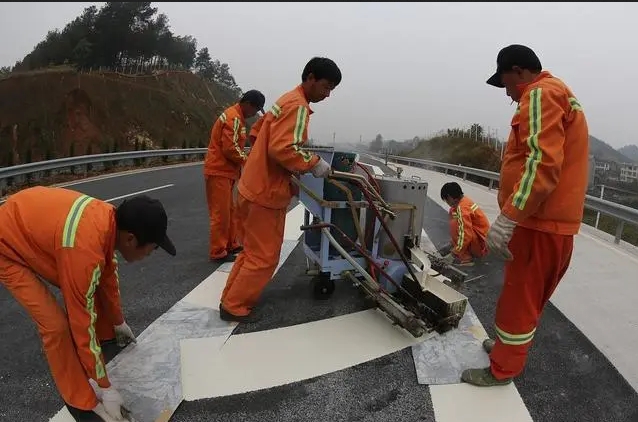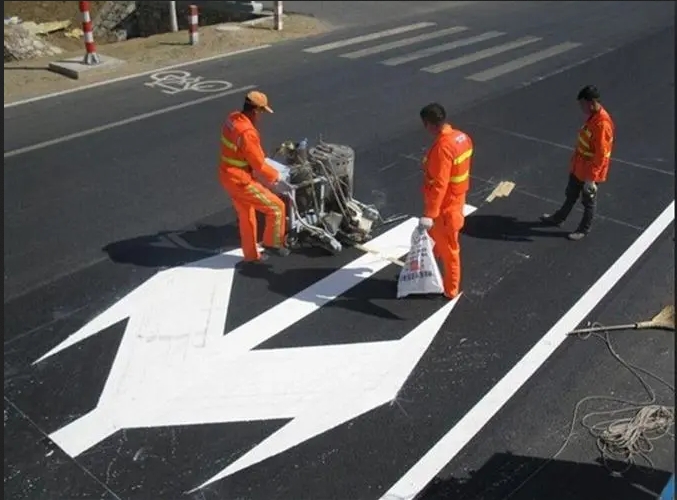Road Marking Paint and Machine Manufacturer
+86-15668659958
Road Marking Paint and Machine Manufacturer
+86-15668659958
1、 Common quality defects of hot-melt road markings
1.1 Coating surface contamination
Surface contamination of coatings is an inevitable issue for road markings. Generally speaking, external factors such as weather, construction, and internal factors such as hot-melt coating materials will all affect the degree of contamination on the coating surface. Among them, factors such as weather conditions, construction quality, and usage location have a significant impact on coating surface pollution. As a thermoplastic hot melt coating, when the temperature is too high, the coating is prone to softening and the surface adhesion will increase. Under conditions that are prone to adhesion and fouling, the coating surface will be contaminated. Especially in areas where vehicles frequently start, brake, and turn around at road intersections or stops. At the same time, the hot melt coating material is thermoplastic, and when it softens at high temperatures, the surface becomes sticky and the roughness increases, resulting in a corresponding decrease in brightness.
1.2 Coating discoloration
The main components of hot melt coatings include pigment fillers, resins, additives, reflective materials, etc. As organic substances, resins, additives, etc., it is inevitable to cause discoloration of the coating film after thermal cracking, which puts higher requirements on the heating temperature during construction. Meanwhile, the overheating of the preheated coating and the mixing of edge coke are also major reasons for the discoloration of the coating. The main reason for the discoloration of the coating is that the markings have been exposed to direct ultraviolet radiation for a long time, resulting in their color fading.
1.3 Poor nighttime reflective effect The nighttime reflective effect of hot melt coatings is influenced by multiple factors. Among them, the quality and performance factors of coating materials and reflective materials themselves, as well as factors such as construction equipment and skills, are also affected by environmental conditions and road conditions. Any one of the influencing factors may lead to poor reflective effect of the markings.
During the construction process, the fluidity and viscosity of the coating will affect the dispersion and fixation of reflective materials such as glass beads. If the coating is too hard, it will make the glass beads unstable, which will result in the glass beads being easily worn off by the wheels. If the coating is too soft, the glass beads are pressed into the coating, thereby failing to achieve the reflective effect of the glass beads. At the same time, the quality of glass beads is also an important factor affecting the reflective effect. Due to poor storage. Causing moisture, uneven drop, or mixing of debris in glass beads will directly affect the reflective effect.
In the study of reflective effects, the construction environment and conditions of road markings will have a certain impact on the reflective performance of the markings. If construction is carried out under strong wind conditions, it will cause glass beads to gather on one side, affecting the overall reflective effect. If the construction is carried out directly on old markings and uneven road surfaces, it will cause uneven coating film thickness, thereby affecting the fixation status of glass beads and affecting the reflective effect of road markings.
1.4 Peeling and peeling
Quality defects are common construction problems, and as one of the most serious consequences of quality defects, the harm of peeling cannot be underestimated. It will directly cause the marking to lose its marking function and also affect the beautification zone of the road environment. Generally speaking, the main reasons for peeling and peeling are defects in coating materials, construction conditions, and construction environment.
Among them, the phenomenon of cracking and peeling is relatively common, mainly due to the fact that the hot melt coating is a thermoplastic material that becomes rigid after cooling and is prone to peeling and peeling at the fracture site. At the same time, if construction is carried out directly on the old markings, it is also easy to cause peeling and peeling. The main reason is that the surface of the old marking film itself is generally relatively smooth, and peeling and peeling are also common when the construction conditions are not well understood.
At the same time, the construction conditions also have a significant impact on it. Poor cleaning during construction, insufficient dryness of the road surface, low construction temperature, and low temperature of the coating itself will directly affect the adhesion of the coating, leading to peeling and peeling.
1.5 Cracks
Cracks in the coating of hot-melt road markings are inevitable and require attention. Minor cracks generally do not have a significant impact on the quality of markings, but severe cracks and larger cracks will have a certain impact on the quality, durability, and adhesion of markings. There are various types of cracks, generally including the following:
(1) Common cold cracks on asphalt pavement. The formation of this crack is mainly affected by the cold climate, and the coating layer shrinks when cold, forming internal shrinkage stress. When the stress is concentrated, it may lead to cracking. This phenomenon is not common on concrete pavement.
(2) The accompanying cracks formed by coating cracking due to road surface cracking are also a major type of crack.
(3) Under high temperature conditions in summer, when asphalt pavement is heated, it will become soft, while the hot melt coating layer will be harder. When it is subjected to the impact force of tires, cracks will appear, which is called soft pavement cracks.
(4) The appearance of surface cracks in the coating is mainly due to the upward floating of resin segregation in the coating under high temperature conditions. The main reasons for this situation are the high temperature of the coating during construction and the slow cooling caused by the coating being too thick. Although the resin segregated onto the surface of the coating is mixed with the additives, the volatilization of the additives will cause the resin to weather, resulting in surface cracks.
(5) Circular cracks are also one of the common cracks, which are more common on cement concrete pavement and porous old asphalt pavement. Under the influence of sunlight, road markings may experience softening of the coating and expansion of microporous moisture due to heat, which can cause the coating to bulge with a large blister layer. When pressed by the car tires, circular cracks will appear when the top of the blister re adheres to the ground.
(6) Aging cracks are caused by the temperature difference, periodic expansion and contraction of the coating, as well as the internal stress caused by different expansion coefficients. At the same time, the degradation of the coating material and natural weathering are also the main reasons for the formation of aging cracks.

1.6 Micropores and foaming
The occurrence of micropores and bubbles in road markings is relatively common. The main influencing factors include road conditions, construction performance, construction conditions, and types of road materials. Microbubbles are the products formed by gas and volatile substances penetrating the coating film after being heated and expanded, while bubbles are formed by expanding gas without passing through the coating. The main reason for its formation is the expansion or gasification of water, air, and coating agents in the concave part of the road surface and its fine pores under the high temperature of the coating.
1.7 Poor surface condition
Poor surface condition is also a major manifestation of quality defects in road markings. The appearance of poor surface condition will have an impact on the visual effect, usability, and reflective performance of the coating. Generally speaking, poor surface condition of road markings should be noted as the appearance of longitudinal stripes, transverse stripes, and pockmarks on the surface. The longitudinal stripes of the coating are caused by quality issues with the coating material. When poor fluidity and overburned solids are mixed into the coating, longitudinal stripes will be formed. The horizontal stripes of the coating are caused by uneven road surfaces, and the main factor is the high viscosity or thermal cracking of the coating, which causes the coating to thicken and form horizontal stripes. Coating pitting is more common in situations where the coating is thickened and contains water. The insufficient fluidity of the coating itself, combined with the dual effect of road surface cavities, can lead to the formation of coating pitting.
1.9 Line deformation
During the use of road markings, they gradually change and deformation is also common. The common deformation of markings is mainly serpentine, wrinkled, and tire imprinting. Most of these deformations are caused by changes in the road surface. The common types of asphalt pavement are coating snaking and wrinkles. When the temperature is too high, the asphalt softens, and under the impact of the wheel, it shifts, causing the markings to snake. In addition, the coating is a thermoplastic material that can also soften at high temperatures, but has a higher softening point than asphalt. The difference in expansion coefficient between the two will lead to wrinkles.

2、 Common Countermeasures for Hot Melt Road Marking Problems.
Different quality defects of hot-melt road markings need to be analyzed and solved according to local conditions. After considering the reasons for its occurrence, a comprehensive analysis is needed to solve the problem reasonably and efficiently. Generally speaking, in order to avoid or reduce the occurrence of these defects, we not only require good performance of coatings and related materials, but also need to take corresponding measures based on local conditions.
Generally speaking, keeping the construction section road surface dry and clean, while controlling the construction temperature, will help to enhance the adhesion between the coating and the road surface, thereby avoiding reducing the service life of the coating. The relevant person in charge should also select appropriate coatings based on the geographical environment and climate conditions of the construction.
In terms of mechanical equipment, using spraying machinery and using spraying specialized coatings is also a major way to avoid problems with road markings. At the same time, attention should be paid to marking the construction line after the primer is completely dry. For cement concrete pavement construction, special permeable special primer should be used. The typical coating thickness is 1.2-2.0mm. When storing materials, attention should also be paid, such as placing reflective glass beads in a dry environment to avoid moisture and clumping.
Summary: Road markings are an important component of traffic safety facilities, and their role in modern highway transportation cannot be replaced. So we must pay attention to the construction of road markings, solve and reasonably handle related problems, make road markings more practical and reliable, in order to play its maximum role.


